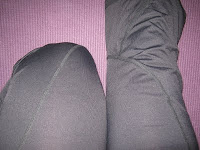Reposted on February 3rd as photos don't seem to be displaying correctly.
This pose is a combination of Virasana (heros pose), Dandasana (staff pose) and Paschimottanasana (forward bend). In YOGA: The Path to Holistic Healing, by B.K.S. Iyengar, he says that the literal meaning of trianga is "three parts of the body". So, in this pose, the three parts of the body are the buttocks, knees and feet. Please remember that the instructions given are only a general guideline.
Above are possible props you may need to attain correct alignment in this pose. I also forgot to include a bolster in the picture..so it should be there too!
Begin in Dandasana (staff pose). Make sure both sitting bones are pressing evenly into the floor. The legs extend out and press out through heels. Keep the knees pointing up to the ceiling and engage the thigh muscles. The thigh bones press down to the floor. From the base of the spine, lengthen up the spine, keeping the crown of the head parallel to the ceiling and the shoulders moving back and down away from the ears. The throat, eyes and abdomen should be soft. If you are not able to sit on the floor with the legs straight or the back straight place some height under the buttocks.
Bend the right knee and bring the right foot back beside the right outer hip. Use your hand to cut the calf muscle in half and roll the outer side out, giving more space behind the knee. While the left leg remains straight, kneecap pointing up to the ceiling, the thighs should remain parallel. Ground both sitting bones.
If the sitting bones are both grounding evenly the hips should look even and be parallel.
If both sitting bones are not pressing evenly to the floor and the hip on the bent knee side lifts up place height under the sitting bone of the straight leg.
The height, whether foam blocks, a bolster or blanket should only go under the buttock of the straight leg.
Keep a strap handy by..and then inhale and raise the arms up overhead. Lengthen from the hips to the fingertips so both sides of the torso lengthens evenly. The shoulders move down and back.
On the exhalation, reaching for the extended foot, keep the spine concave. If you cannot reach the foot without rounding the back take hold of the strap around the foot.

Coming into the forward bend, the bend should come from the hip crease, not the abdomen. Press into the bent leg shin and the back of the straight leg and as you exhale again, allow the abdomen to soften inward toward the spine and release forward as if you were trying to hook the ribs over the knee. Keep the shoulder blades moving down and into the body. If the hand can reach the foot release the forehead towards the knee or shin. Draw the elbows out to the side in line with the shoulders and keep the breastbone lifting up. Gently roll the right ribs towards the left. If it feels like you are rolling to one side use more height.
If the hamstring muscles at the back of the leg are very tight and the shoulders are tight stay at the concave back stage for awhile.
If the forehead does not quite reach the shin without straining the back of the neck place a bolster horizontally across the shin and rest the forehead on the bolster. The bolster also helps support the elbows, allowing the upper back muscles to relax and release down.
The next three pictures are even more variations if you find it difficult to reach the shin or bolster across the shin.
Place a chair on the mat in front of you and reach the arms up the back seat of the chair to the point where the shoulders can release back and down and the forehead can rest easily.
Rest a bolster against the chair.
Or rest the bolster on the chair.
In all the variations, with or without support under the hip make sure that the legs remain active. Keep the outer thigh of the straight leg rolling in, kneecap up, press out through heel. Press into bent leg shin. That action will help keep the spine lengthening up from the base of the spine.
Side view: If you are sitting up on height and feel any strain at the back of the knee or hyper-extend the knee place a rolled blanket or towel under the knee.
Top view: Place the blanket only under the straight leg.
Benefits: Tones and simulates circulation in the pelvis and abdominal organs, helps with digestion and tones the liver helping with the effects of excess bile secretion, reduces flatulence and constipation, brings flexibility to knee joint and helps make the body supple and agile and helps to correct dropped arches and flat feet. This pose is also calming to the nervous system.
Cautions: If have a lower back injury only practice the concave back stage. Don't let torso twist or lean to the outer side of straight leg so spine and abdominal organs are not strained. If have a knee issue do not do without help and support. Also avoid during menstruation if have ovarian cysts, endometriosis, fibroids or migraine headache.
Enjoy the benefits of this pose!
Namaste!
Pamela Nelson



















No comments:
Post a Comment
Note: Only a member of this blog may post a comment.